Frame Relay (frame relay) is a packet switching technology that fragmented into transmission units called frames and sent in high-speed bursts through a digital network. Establishes an exclusive connection during the transmission period called virtual connection.
It uses a technology called fast packet in which error checking does not occur in any intermediate node of the transmission but done at the ends. It makes it more efficient than X.25, and a higher process speed achieved (it can transmit over 2,044 Mbps).
Another advantage is that you need less powerful switching centers (nodes) and with less memory capacity than those needed by X25 (each X25 switching center uses the receive-store-check-relay method, while Frame Relay does not need checking or correcting errors).
If the traffic is hefty, with a large number of small packages, its performance is more excellent than X25.
If large files transferred at high speeds, the price/performance ratio is higher in X25.
Frame relay has evolved from X.25 packet switching and objective is to reduce network delays, protocol overheads and equipment cost. Error correction is done on an end-to-end basis rather than a link -to-link basis as in X.25 switching. Frame relay can support multiple users over the same line and can establish a permanent virtual circuit or a switched virtual circuit.
Frame relay is considered to be a protocol, which must be carried over a physical link. While useful for connection of LANs, the combination of low throughput, delay variation and frame discard when the link is congested will limit its usefulness to multimedia.
•Packet switching was developed when the long distance digital communication showed a large error rate.
•To reduce the error rate, additional coding bits were introduced in each packet in order to introduce redundancy to detect and recover errors.
•But in the modem high speed telecommunication a system, this overhead is unnecessary and infect counter productive.
•Frame relay was developed for taking the advantage of the high data rates and low error rates in the modem communication system.
• The original packet switching networks were designed with a data rate at the user end of about 64 kbps.
• But the frame relay networks are designed to operate efficiently at the user’s data rates upto 2 Mbps.
• This is possible practically because most of the overhead (additional bits) are striped off.
• Frame relay is a virtual circuit wide area network which was designed in early 1990s.
• Frame relay also is meant for more efficient transmission scheme than the X.25 protocol.
• Frame Relay is used mostly to route Local Area Network protocols such as IPX or TCP/IP.
• The biggest difference between Frame Relay and X.25 is that X.25 guarantees data integrity and network managed flow control at the cost of some network delays. Frame Relay switches packets end-to-end much faster, but there is no guarantee of data integrity at all.
Various key features of this protocol are as follows:
1. The call control packets are used for setting up and clearing virtual circuits.
2. In band signaling is used.
3. Multiplexing of virtual circuits takes place at layer 3.
4. Layer 2 and 3 include flow control and error control.
We’ll be covering the following topics in this tutorial:
Characteristics of Frame Relay
- Frame Relay service is a service that supports the transport of data
- Frame relay is a connectionless service, meaning that each data packet passing through the network contains -address information
- Frame relay is a service that is provided with a variety of speeds from 56 Kbs up to 25 Mbs.
- Even though the most used speeds for the service are currently 56 Kbs and 1.544 Mbs
- Frames are variable in length and goes up to 4,096 bytes
- Frame Relay is considered to be a Broadband ISDN service
- One of the unique facets of frame relay service is that the service supports variable size data packets.
Features of frame relay:
Some important features of frame relay are :
1. Frame relay operates at a high speed (1.544 Mbps to 44.376 Mbps).
2. Frame relay operates only in the physical and data link layers. So it can be easily used in Internet.
3. It allows the bursty data.
4. It has a large frame size of 9000 bytes. So it can accommodate all local area network frame sizes.
5. Frame relay can only detect errors (at the data link layer). But there is no flow control or error control.
6. The damaged frame is simply dropped. There is no retransmission. This is to increase the speed. So frame relay needs a reliable medium and protocols having flow and error control.
Frame Format
The frame format used in frame relay.
- • The DLCI length is 10 bits
- • There are two EA locations. The value of the first one is fixed at 0 and the second at
- • 1 is set in the DE (Discard Eligibility) for the part that can be discarded first when congestion occurs
- • The data size may vary up to 4096 bytes.
Frame relay layers
• Frame relay has only two layers i.e. physical layer and data link layer.
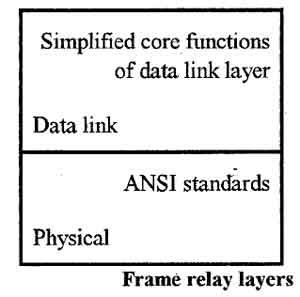
Physical layer
• Frame relay supports ANSI standards.
• No specific protocol is defined for the physical layer. The user can use any protocol which is recognized by ANSI.
Data link layer
• A simplified version of HDLC is employed by the frame relay at the data link layer.
• A simpler version is used because flow control and error correction is not needed in frame relay.
The need for frame relay:
• The frame relay is being used for a number of reasons. Some of the important reasons are as follows:
1. Higher data rates.
2. It allows transfer of bursty data.
3. It has lower overheads.
• Let us discuss these points one by one.
1. Higher Data Rates
It allows transfer of bursty data.
• If the LANs located at physically distant places are to be connected to each other then there are two options available to do this.
1. Interconnect them using the T lines.
2. Interconnect using the frame relay.
• Fig. (a) Shows four such LANs interconnected via T-lines. The T-lines offer a high data rate but they make point to point connectiol1$. Hence we need 6 T-lines to connect each LAN to the remaining three.
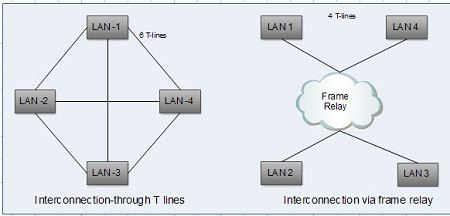
• Now refer Fig. (b) in which the LANs are interconnected via a frame relay. This requires only 4 T-lines. The saving increases with increase in the number of LANs.
• For the direct interconnection of Fig.(a), once a T-line is used, we have to pay a fixed charge for it irrespective of its usage because it is a leased line.
• The T-lines of Fig.(a) may be fully utilized sometimes and not utilized at all at other times.
• The frame relay network can handle data rates upto T-3 transmission i.e. 44.376 Mbps.
2. Can handle bursty data:
• The data being sent from a source to destination is not of continuous/constant nature.
• Instead it is bursty in nature. That means a large amount of data (data burst) is sent suddenly, then for sometime there is very little or no data.
• The T-lines are not equipped to handle such bursty data because they offer a constant data rate.
• The frame relay can tackle this problem. It supports a minimum average data rate and can handle the bursty data.
3. Lower overheads:
• In frame relay network, there are no acknowledgements sent from the switches back to the sender.
• There is no intermediate error check. The error checking takes place only at the destination.
• The intermediate host/switch does not keep a copy of the packet forwarded to the next host/switch. This saves a lot of memory space of the hosts and switches.
• All this lead to reduced overheads.
Frame relay architecture:
• Frame relay can provide two types of virtual circuits.
1. Permanent Virtual Circuits (PVC).
2. Switched Virtual Circuits (SVC).
• Fig. Shows the frame relay network connected to internet. The routers connect LANs and WANs in the Internet.
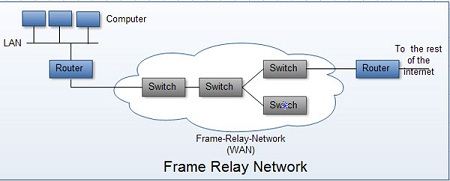 Virtual Circuits:
Virtual Circuits:
The virtual circuits in frame relay are called as Data Link Connection Identifier (DLCI).
This is actually a number which identifies a virtual circuit in frame relay.
Switches:
• The switches in frame relay are supposed to route frames. For this each switch has a table.
• The routing procedure is same as that in the data transfer mode except for one change. VCIs are replaced by DLCIs.
How frame relay works?
• Frame relay can support the Permanent Virtual Circuit (PVC) as well as Switched Virtual Circuits (SVC).
• Whether to use PVC or SVC is decided by the user, based on the data transmission requirements and the budget. 
• The Frame Relay works on the basis of virtual circuits. These virtual circuits are created and used in the data link layer.
• Each virtual circuit is identified by a number called Data Link Connection Identifier (DLCI).
• When a virtual circuit is established, a DTE (Data Transmission Equipment) is provided with a DLCI which it can use to communicate with the remote DTE.
• Assume that a virtual circuit has been established between computers A and C using the DLCI numbers of Fig.
• Then computer A uses DLCI = 68 (i.e. that of C) while sending a packet from A to C. On the other hand, computer C uses DLCI = 30 (that of A) while sending a packet from C to A.
• The DLCI numbers are assigned permanently if PVC IS being supported and on a per connection basis if SVC is supported.
Frame relay switching:
• A frame relay uses the concept of switching in order to route packet from the sender to receiver.
• Each switch is a special type of computer that can forward packets based on the address contained in the packet.
• Fig. shows the basic frame relay network.
• In Fig. there are three frame relay switches which are connected to several computers.
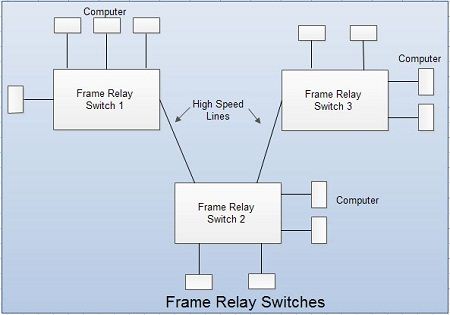
• The process of forwarding a packet has been illustrated. 
• The Frame Relay switch of Fig. has three incoming and four outgoing interfaces.
• The incoming interface-l receives two packets wit~ DLCI numbers 58 and 25.
• The switching table for the frame relay switch is shown in Table.
• As per this table the packet with DLCI number 58 is forwarded to the outgoing interface-
3 and that having DLCI number 25 is forwarded to interface-I.
Frame relay frame:
The structure of the Frame Relay frame shown in the figure. The Frame Relay package, very similar to the X.25 package, has the following components:
• Figure Shows the frame relay frame format. This frame is very similar to the HDLC frame except for the missing control field here.
• The control field is not needed because flow and error control are not needed.
• The Flag, FCS and information fields are same as those of HDLC.
• The address field defines the DLCI along with some other bits required for congestion control and traffic control.
• Their description is as follows:
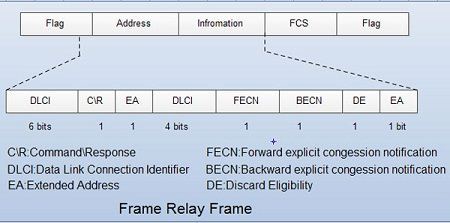 1. DLCI field:
1. DLCI field:
The first part of DLCI is of 6 bits and the second part is of 4 bits. They together form a 10 bit data link connection identifier.
2. Command / Response (C / R):
The C/R bit allows the upper layers to identify a frame as either a command or response. It is not used by the frame relay protocol.
3. Extended Address (EA):
• This bit indicates whether the current byte is the final byte of the address.
• If EA = 1 it indicates that the current byte is the final one but if EA = 0, then it tells that another address byte is going to follow.
4. Forward Explicit Congestion Notification (FECN):
• This bit can be set by any switch to indicate that traffic is congested in the direction of travel of the frame.
• The destination is informed about the congestion via this bit.
5. Backward Explicit Congestion Notification (BECN):
• This bit indicates the congestion in the direction opposite to the direction of frame travel.
• It informs the sender about the congestion.
6. Discard Eligibility (DE):
• The DE bit indicates the priority level of the frame. In the overload situations a frame may have to be discarded.
• If DE = 1 then that frame can be discarded in the event of congestion.
• DE bit can be set by the sender or by any switch in the network.
Extended address (Frame Relay Assembler I Disassembler) :
The frame relay address has been extended from the original 2 byte address to 3 or 4 byte address, in order to increase the range of DLCIs.
FRADs:
• FRAD (Frame Relay Assembler/Disassembler) is a device used by frame relay to handle frames arriving from other protocols.
• A FRAD assembles and disassembles frames coming from other protocols.
 VOFR:
VOFR:
• This is an option offered by frame relay. Its long form is Voice Over Frame Relay.
• VOFR allows voice transfer on the frame relay. Voice is transferred in the digital form with the help of PCM.
• This is an inexpensive way of sending voice over long distance. But the quality of sound is not very good.
LMI:
• Originally there was no provision for control and management of interfaces in the frame relay because it was designed to provide PVC connection.
• So recently a protocol called LMI (local management information).
• This protocol provides management features such as :
1. A mechanism to check if data is flowing.
2. A multicast mechanism.
3. A mechanism to check the status of a switch.
Congestion control and quality of service:
One of the advantages of frame relay is that it provides congestion control and quality of service.
Advantages of frame relay:
Some of the advantages of frame relay are:
1. Streamlined communication process.
2. The number of functions of a protocol at the user-network interface is reduced.
3. Lower delay.
4. Higher throughput.
5. Frame relay can be used at access speeds upto 2 Mbps.
6. Frame Relay is cost- effective, partly due to the fact that the network buffering requirements are carefully optimized.
7. Compared to X.25, with its store and forward mechanism and full error correction, network buffering is minimal.
8. Frame Relay is also much faster than X.25: the frames are switched to their destination with only a few byte times delay, as opposed to several hundred milliseconds delay on X.25.
Disadvantages of frame relay:
1. Frames are delivered unreliably.
2. Packets may not be delivered in the same sequence as that at the sending end.
3. Packets having errors are simply discarded.
4. Frame relay does not provide flow control.
5. It does not provide the acknowledgement of received packets.
6. Frame discarded in case of network congestion. If congestion occurs in the network, frame (data) is discarded within the network without re-transmission of this frame. The sender must perform re-transmission control at his own responsibility.
Congestion control in frame relay networks:
• The frame relay network implements a simple congestion control mechanism in which involves congestion notification.
• The two congestion notification mechanisms are as follows:
1. FECN : Forward Explicit Congestion Notification.
2. BECN: Backward Explicit Congestion Notification.
• Both these are controlled by a single bit contained in the frame header of frame relay.
• The frame header of frame relay also contains a Discard Eligibility (DE) bit. It is useful in identifying the less important traffic which can be dropped in the event of congestion.
• The FECN bit is a part of the address field of the frame header.
• If the network is congested, the FECN bit is set to 1. When such frames reach the destination, the FECN = 1 indicates the presence of congestion. The flow control can then be initiated or the indication may be ignored.
• As shown in Fig. the FECN bit travels to the destination i.e. in the direction of transmission.
• The BECN bit also is a part of the address field of the frame header.
• The value of BECN bit is set to 1 in the frames that traveling in the opposite direction (to the sender).
• The BECN = 1 indicates congestion and the flow control is exercised to control the congestion.
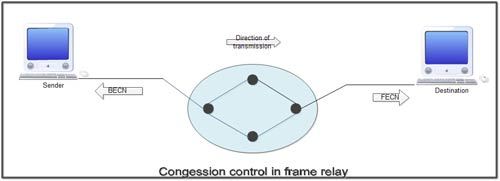 Discard Eligibility (DE):
Discard Eligibility (DE):
• If “DE” bit of a frame is set to 1 then it shows that, the particular frame has lower importance than the other frames.
• In the event of congestion, the frames with DE = 1 are discarded first to reduce the possibility of critical data getting affected by the congestion.
Frame Relay and the OSI Reference Model
Frame relay constitutes of the OSI second layer (data link layer). Above that layer the protocol may be determined as desired by the user. Therefore, the IP protocol (the third-layer protocol) which is commonly used for LAN can be used without any modification.
 Dinesh Thakur holds an B.C.A, MCDBA, MCSD certifications. Dinesh authors the hugely popular
Dinesh Thakur holds an B.C.A, MCDBA, MCSD certifications. Dinesh authors the hugely popular